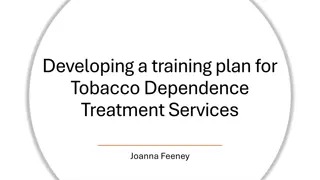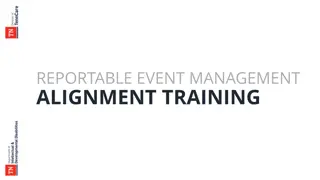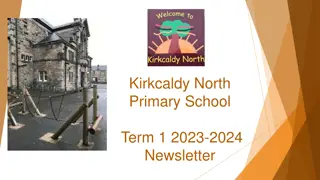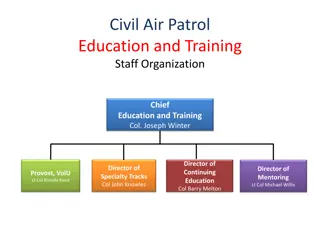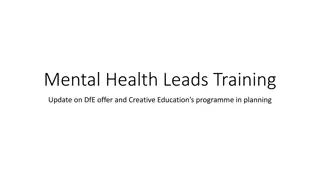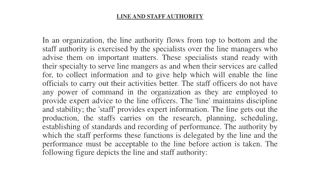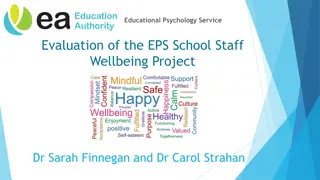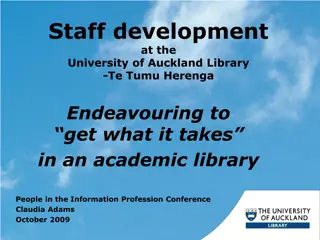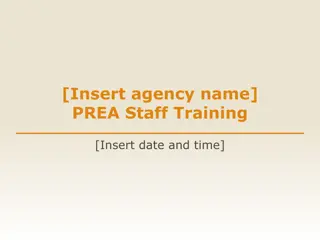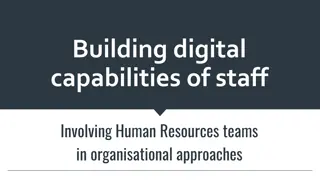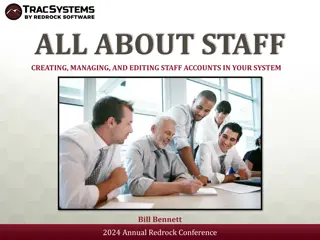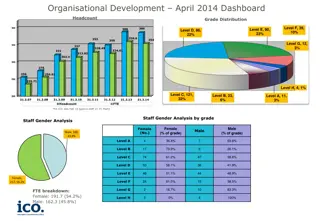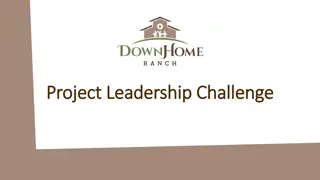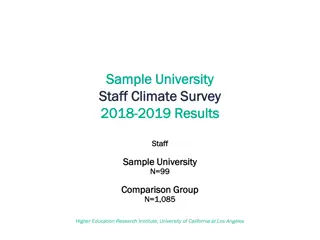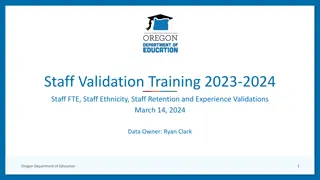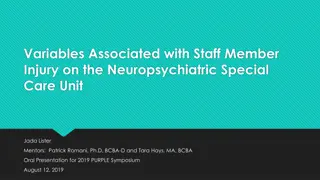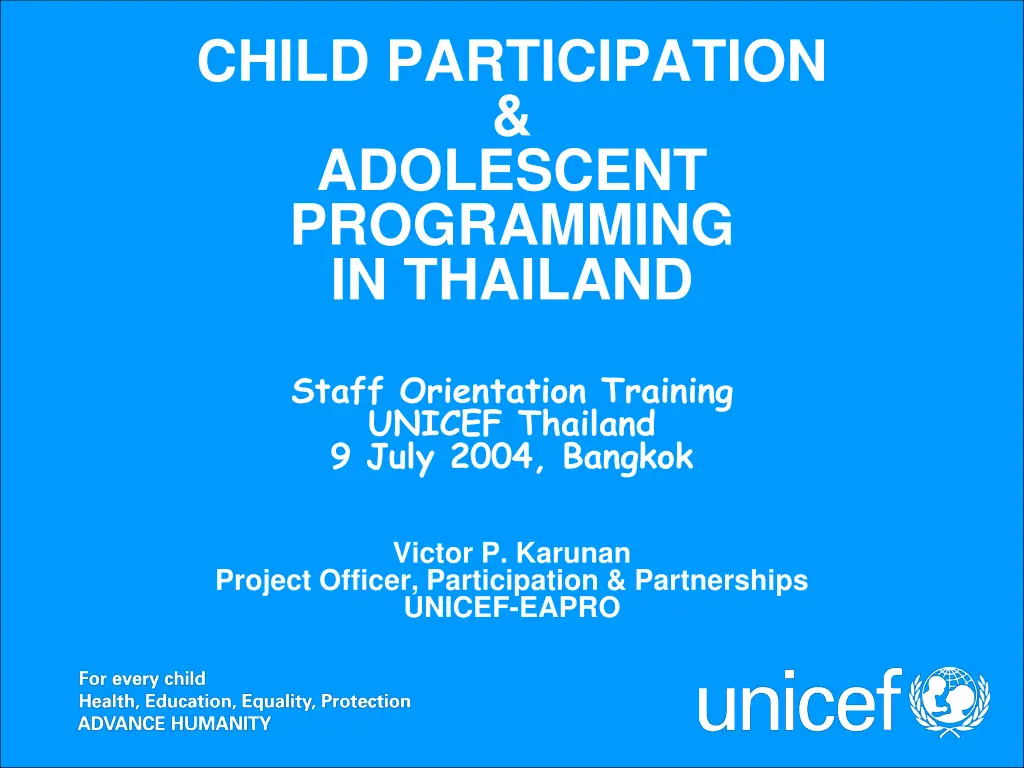
Understanding Child Participation in Thailand
Explore the purpose, agenda, and exercises of a UNICEF staff orientation training in Thailand focused on children's participation and adolescent programming. Gain insights into the definitions of child, adolescent, youth, and young people, as well as the key elements of meaningful participation. Discover the importance of participation, its processes, and responsibilities for both children and adults.
Download Presentation

Please find below an Image/Link to download the presentation.
The content on the website is provided AS IS for your information and personal use only. It may not be sold, licensed, or shared on other websites without obtaining consent from the author. If you encounter any issues during the download, it is possible that the publisher has removed the file from their server.
You are allowed to download the files provided on this website for personal or commercial use, subject to the condition that they are used lawfully. All files are the property of their respective owners.
The content on the website is provided AS IS for your information and personal use only. It may not be sold, licensed, or shared on other websites without obtaining consent from the author.
E N D
Presentation Transcript
CHILD PARTICIPATION & ADOLESCENT PROGRAMMING IN THAILAND Staff Orientation Training UNICEF Thailand 9 July 2004, Bangkok Victor P. Karunan Project Officer, Participation & Partnerships UNICEF-EAPRO
Session 1 PURPOSE & AGENDA OF WORKSHOP
Purpose and Objectives 1. To level-off on our common understanding of children participation in the Thai context 2. To familiarise ourselves with UNICEF s corporate approach and strategy on promoting child and adolescent participation and development 3. To review obstacles and gaps in Thai context 4. To agree on some action points and next steps
Conceptual Confusions. Child : under 18 years of age (CRC) Adolescent : 10 to 19 years Youth : 15 to 24 years Young People : 10 to 24 years PERHAPS A MORE APPROPRIATE TERM IN THIS REGION Children and Young People
Tentative Agenda Session 1 : Welcome & Introductions : Purpose & Agenda Session 2 : Understanding Child Participation Learning Exercise Session 3 : UNICEF s Approach and Strategy on Child/Adolescent Participation and Development Session 4 : Group Work : Review of obstacles & gaps in Thai context Session 5 : Adolescent Programming Guidelines & Tools Session 6 : Action Points & Next Steps
Session 2 UNDERSTANDING CHILD PARTICIPATION
Understanding Child Participation Learning Exercise 1 : Individual and Group Work Q : What does child participation mean to me? Q : List three essential elements of meaningful participation of children and adolescents. Write answers on VIPP cards (10 mins) Discuss and agree in groups (20 mins)
What is Participation? Participation is : - the process of sharing decisions which affects one s life and the life of the community an involvement that can differ in form and style when children are at different ages ( evolving capacities ) a skill that must be learned and practiced a responsibility and an obligation for children and adults alike put into practice, participation involves adults listening to children
The Right to Participate - Participation is a human right - a means to an end, as well as an end in itself - Participation is a right for ALL - not an option that can be withheld from children/youth - Participation is voluntary - children/youth need to be invited and encouraged, not coerced or manipulated - Resistance or non-participation can be an important form of participation - Participation challenges power relations and the status quo - Participation does not mean that children/youth make all the decisions on their own : child-adult relationships are important for effective participation.
What is meaningful participation? - Must start with children and young people themselves - on their own terms, within their own realities and in pursuit of their own visions, dreams, hopes and concerns - Children need information, support and favourable conditions to meaningfully participate - It is about valuing people (children/young people) - It is determined by the given socio-cultural, economic and political context
Understanding Participation An ongoing process of children/adolescent expression and active involvement in decision-making A process by which children and adolescents develop their knowledge, skills and competencies to engage in society A process that gives children/adolescents an opportunity to shape both process and outcomes of an event or action.
How to work with children and adolescents? We need to make a mind-shift in the way we view children and young people We need to work towards creating a safe and supportive environment - family, school, community, peer group, society We need to build equal partnerships with adolescents and young people.
Pre-requisites for promoting meaningful participation 1. Recognition and respect for children s agency and capacity 2. Information sharing and dialogue between children and adults based on mutual respect 3. Understanding and respect for children s evolving capacities 4. Conducive and participatory environment in family, community and society
Session 3 UNICEF S APPROACH AND STRATEGY ON CHILD/ADOLESCENT PARTICIPATION & DEVELOPMENT
UN Special Session Follow-up Road-Map 2002 (3 Areas) 1. Partnerships : (Office of Public Partnerships) - developing a strategic approach to partnerships - assessment of potential partners - MDG/WFFC targets as basis for building partnerships - broad-based partnerships : c/yp, youth networks, civil society, faith groups, media, private sector
Road Map (Contd) 2. National Policies : - First Stage : broad-based consensus representation and involvement of c/yp - Second Stage : develop NPA or National Mechanisms (National Development Plans, PRSP) by end 2003 - Involvement of c/yp in NPA process monitoring & reporting (Ref : Save the Children guide)
Road Map (Contd) 3. Participation : - Active and meaningful participation of c/yp in keeping with their evolving capacities - UNICEF offices to support capacity development of key government agencies and national NGOs for using participatory approaches
UNICEF Regional Office Set-up tracking system on national actions for WFFC implementation including innovative approaches to child/youth participation, partnerships and social mobilisation Regional Meetings, Reviews and Progress Reports Mid-Decade Review of WFFC 2005/2006 for SG s report to GA in 2006
UNICEFs Corporate Position on Children and Young Peoples Participation State of the World s Children 2003 on Child Participation To draw public attention to the importance of c/yp participation To encourage State, civil society and private sector to promote meaningful participation Examples of good practices around the world Stimulate actions to promote c/yp participation in MDG/WFFC implementation
Ex-Dir : E/ICEF/2003/CRP.3 11 Dec.2002 Ensure participation of children and young people and civil society in reviews of MDG/WFFC implementation as well as of national policies/NPAs Build partnerships for social mobilisation with c/yp, NGOs and civil society groups
Programme Implications Participation Guide PPP Manual 2003 THE CONTEXT - Negative attitudes/biases towards participation from govt. agencies, civil society, others - Need for positive approach to c/yp participation - Participation rights included in WFFC thereby committing Govts to fulfill them - C/YP are often better placed to analyse situation, take initiatives, design solutions to their own problems - Participation helps c/yp to build their competencies, develop skills and gain confidence
Participation Guide (Contd) PRINCIPLES & ETHICS - Guiding principles : Human Rights & CRC - Special attention to marginalised c/yp - Mutual respect : child-adult - Informed consent - Participatory context/environment (home, school) - Confidentiality - Realistic Expectations : child-adult
Participation Guide (Contd) HUMAN RIGHTS APPROACH Rights of children and young people vis- - vis Duties of parents/govt Possible strategies : (a) identify and address unfulfilled rights, (b) claiming of rights, (c ) identifying solutions and duties, (d) participating in implementing solutions, (e) monitoring and reporting.
Participation Guide (Contd) PARTICIPATION IN LOCAL/NATIONAL CONTEXT Creating spaces and opportunities for participation Building capacities and skills of adults and c/yp in participation including organisational capacities Creating a wider enabling environment policies, laws
Participation Guide (Contd) SOME ENTRY POINTS FOR PARTICIPATION Using local structures, mechanisms and initiatives Creating platforms e.g., children parliaments Using settings close to c/yp : home, school, community centre, playground Partnerships with children and young peoples organisations and networks Advisory groups/bodies involving c/yp
Understanding Child Participation Learning Exercise 2 : 1. To each question/statement that is read out, choose one answer from four answers displayed in four corners of the room 2. You will be asked Why? you have made this choice
Question 1 You are now taking the very first step to promote meaningful children and young peoples participation with whom would you start? Why?
Question 2 All children have equal abilities and skills to participate effectively. Do you agree/disagree/not sure?
Question 3 Children and Young People benefit in a variety of ways from participating in activities and programmes. If you have to choose one, what in your opinion is the most important benefit to them? Why?
Question 4 Children and adolescents can participate only with the help and support of parents and adults. Do you agree? Why?
Question 5 In Thailand, UNICEF s approach and strategy of working with and for children and young people can be best described as .???
Session 4 : Review of obstacles/gaps in Thai context GROUP WORK Method : Questions for discussion : (approx. 30 mins) (1) Discuss in groups at least 2 (two) obstacles to promoting meaningful children and youth participation in each of the following areas Children & Youth (among peers) Parents/Elders (in family) Teachers (in school) Community (in neighbourhood) National Context (in national policy/legal context) (2) Share experiences or lessons learnt on how any of these obstacles or gaps have been overcome or could be overcome. Note key points below
Session 5 INTRODUCTION TO ADOLESCENT PROGRAMMING - Guidelines & Tools
The concept of Adolescence Adolescence is defined by the Oxford dictionary as being between childhood and maturity A transition stage in life that is not valued or recognised in its own right Adolescents are defined by what they are not rather than what they are a deficit rather than an asset based perception They are largely a neglected group their vulnerabilities unrecognised, their potential contributions under-valued They are often only seen as problems
Importance of Adolescence Over 30 per cent of total population in EAP are below 18 years Adolescence is a period of rapid transition and life change Adolescence is a period of great strengths and capabilities And yet, adolescents and young people are generally regarded negatively as beneficiaries , victims , problems
Why focus on Adolescents? Youth are not the sources of problems they are the resources that are needed to solve them. They are not expenses they are investments to be made Adapted from A World Fit for Us Children s Statement to the UN General Assembly Special Session on Children, New York, May 2002
Adolescents Rights and Development Four elements of a framework for programming 1.Information and Equal Opportunities to develop their knowledge, lifeskills and capacities 2.Equal opportunities to access and benefit from services 3.A safe and supportive environment free from exploitation and abuse 4.Opportunities for livelihoods or social support and economic skills-building
An Approach to Adolescent Programming 1. Entry Points : - Identifying opportunities at every stage of UNICEF s programming cycle (e.g., SITANs, planning, MTR, etc) - Addressing issues affecting adolescents (e.g., in health, education, emergencies, child protection, HIV) - Developing a cross-sectoral & holistic approach 2. Opportunities : - media, government consultants, surveys, schools, conferences and meetings 3. Methodologies : - participatory research, surveys, forums, school activities
Adolescent Programmingcontd 4. Range of potential activities : - youth media, education campaigns, contributing adolescent perspectives to government policy in juvenile justice or child protection, forums for addressing rights, school clubs and youth councils. 5. Key Issues to address : - clarification on concept of adolescent participation and programming among all staff and partners - better data/information on young peoples lives - work with both young people and NGOs as partners - greater awareness of developments in the region and globally - child-sensitive structures and ways of working - capacity building in practice of participation
Session 6 FUTURE DIRECTION AND STRATEGY on CHILD/ADOLESCENT PARTICIPATION & DEVELOPMENT FOR UNICEF-THAILAND
Future Direction and Strategy for Programming Setting Objectives for programming with children and adolescents in Thailand Identifying Key Strategies to achieve these objectives - specific programme areas & country programme as a whole Developing a Plan - including monitoring and review of outcomes Implementing the Plan - in a given time- frame
Some suggested Objectives for Programming To promote personal growth and healthy development of children and adolescents in Thailand To promote better awareness - including development of a national policy - for the protection of rights of children and adolescents To address specific violations experienced by adolescents To promote a more positive approach to adolescents and challenge the tendency to criminalise them and their behaviour To create opportunities for enabling their voices to be heard and acted upon - including and especially the marginalised young people To engage young people as agents in the realisation of their rights To create better opportunities for young people to make informed and healthy life choices To address issues for adolescents not being met by other organisations
Some suggested Areas/Strategies for Adolescent Programming 1. Building our knowledge base on children and adolescents (e.g., ChildInfo, SITANs, Youth surveys) 2. Planning Process (e.g., Consulting with children and adolescents, setting objectives and outcomes) 3. Developing approach to programming (e.g., programme design and implementation with partners) 4. Assessing impact and outcomes (e.g., MTRs, programme/project evaluations)
Other Programming Issues Developing a wholistic approach to adolescent programming (e.g., cross-sectoral and cross- cutting initiatives and linkages in country programme) Identifying a focal point person in country office - linked to a cross-sectoral team of programme staff Optimising partners (government, NGOs, youth groups) knowledge and expertise - building equal and strategic partnerships Ongoing Training and Capacity Building - for staff and partners
How can we meaningfully involve children/young people? Step 1 : Understanding the context of participation : - generally a skeptical or negative attitude towards participation in society - government agencies, civil society, others - need for a mind-shift to a positive approach to child/youth participation - children/young people are often better placed to analyse their situation, take initiatives, design solutions to their own problems - participation helps children/youth to build their competencies, develop skills and gain confidence
Involving Children & Young People contd Step 2. Adhering to Key Principles and Ethical Considerations : Using Human Rights and the CRC as the guiding framework for promoting participation Paying special attention to marginalised children and young people Seeking informed consent of c/yp Understanding and strengthening the participatory context and environment (at home, school, community, etc.) Respecting Confidentiality Setting Realistic Expectations : Adults - Children
Involving Children and Young People contd. Step 3. Using entry-points : Use local structures, mechanisms and initiatives in setting up children s groups/networks Use settings close to the children/young people : home, school, community centre, playground, etc. Peer-counseling and peer-communications Involve family, school and community at local levels to support their c/yp participation and development Involve representatives of c/yp in local structures, project committees to provide input/feedback for project planning, implementation, review and evaluation.
Session 7 UNICEF-EAPRO FOLLOW-UP AND NEXT STEPS (2002 - 2004)
Follow-up & Next Steps Regional Level : East Asia and Pacific 1. UNSS FOLLOW-UP : Sustain network of c/yp from UNSS process, Regional Childrens Forum and expand links with youth networks - esp. HIV/AIDS, child protection, human rights Support c/yp participation in implementation of Bali Consensus, WFFC, MDGs Set-up tracking system to document c/yp participation in MTSP priority areas share good practices and lessons learnt
Follow-up : Regional Level (Contd) 2. C/P PARTICIPATION IN PROGRAMMING : Encourage governments to develop or update National Policies and Strategies on Youth Participation & Development Training and Capacity Building of c/yp and adults in meaningful participation and partnership- building in programming esp, for NPA/National Plan implementation, monitoring and reporting (using Participation Guide, Save the Children Guide on NPAs) Share good practices and tools/methods of integrating c/yp meaningful participation in programming

